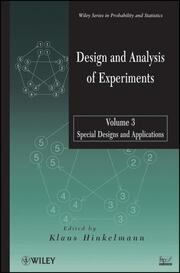Detailansicht
Design and Analysis of Experiments
Volume 3: Special Designs and Applications, Wiley Series in Probability and Statistics 3
ISBN/EAN: 9780470530689
Umbreit-Nr.: 6219851
Sprache:
Englisch
Umfang: 608 S.
Format in cm:
Einband:
gebundenes Buch
Erschienen am 02.03.2012
Auflage: 1/2012
- Zusatztext
- Provides timely applications, modifications, and extensions of experimental designs for a variety of disciplines Design and Analysis of Experiments, Volume 3: Special Designs and Applications continues building upon the philosophical foundations of experimental design by providing important, modern applications of experimental design to the many fields that utilize them. The book also presents optimal and efficient designs for practice and covers key topics in current statistical research. Featuring contributions from leading researchers and academics, the book demonstrates how the presented concepts are used across various fields from genetics and medicinal and pharmaceutical research to manufacturing, engineering, and national security. Each chapter includes an introduction followed by the historical background as well as in-depth procedures that aid in the construction and analysis of the discussed designs. Topical coverage includes: * Genetic cross experiments, microarray experiments, and variety trials * Clinical trials, group-sequential designs, and adaptive designs * Fractional factorial and search, choice, and optimal designs for generalized linear models * Computer experiments with applications to homeland security * Robust parameter designs and split-plot type response surface designs * Analysis of directional data experiments Throughout the book, illustrative and numerical examples utilize SAS(r), JMP(r), and R software programs to demonstrate the discussed techniques. Related data sets and software applications are available on the book's related FTP site. Design and Analysis of Experiments, Volume 3 is an ideal textbook for graduate courses in experimental design and also serves as a practical, hands-on reference for statisticians and researchers across a wide array of subject areas, including biological sciences, engineering, medicine, and business.
- Autorenportrait
- InhaltsangabePreface xvii Contributors xxi 1 Genetic Crosses Experiments 1 Murari Singh, Sudhir Gupta, and Rajender Parsad 1.1 Introduction, 1 1.2 Basic Objectives and Models, 2 1.3 Diallel Mating Design of Type I, 8 1.4 Diallel Crosses: Type II Designs, 14 1.5 Partial Diallel Crosses: No Blocking or Complete Blocks, 25 1.6 Partial Diallel Crosses in Incomplete Blocks, 32 1.7 Optimality, 44 1.8 Robustness, 59 1.9 Three or HigherWay Crosses, 61 1.10 Computation, 65 2 Design of Gene Expression Microarray Experiments 73 Dan Nettleton 2.1 Introduction, 73 2.2 Gene Expression Microarray Technology, 74 2.3 Preprocessing of Microarray Fluorescence Intensities, 76 2.4 Introduction to Gene Expression Microarray Experimental Design, 80 2.5 TwoTreatment Experiments Using TwoColor Microarrays, 81 2.6 TwoColor Microarray Experiments Involving More Than Two Treatments, 86 2.7 Multifactor Two-Color Microarray Experiments, 89 2.8 Phase 2 Designs for Complex Phase 1 Designs, 94 3 Spatial Analysis of Agricultural Field Experiments 109 Joanne K. Stringer, Alison B. Smith, and Brian R. Cullis 3.1 Introduction, 109 3.2 Methods to Account for Spatial Variation, 110 3.3 A Spatial Linear Mixed Model, 116 3.4 Analysis of Examples, 122 4 Optimal Designs for Generalized Linear Models 137 John Stufken and Min Yang 4.1 Introduction, 137 4.2 Notation and Basic Concepts, 141 4.3 Tools for Finding Locally Optimal Designs, 145 4.4 GLMs with Two Parameters, 149 4.5 GLMs with Multiple Parameters, 155 4.6 Summary and Concluding Comments, 161 5 Design and Analysis of Randomized Clinical Trials 165 Janet Wittes and Zi-Fan Yu 5.1 Overview, 165 5.2 Components of a Randomized Clinical Trial, 168 5.3 Bias, 175 5.4 Statistical Analysis of Randomized Clinical Trials, 182 5.5 Failure Time Studies, 184 5.6 Other Topics, 206 6 Monitoring Randomized Clinical Trials 213 Eric S. Leifer and Nancy L. Geller 6.1 Introduction, 213 6.2 Normally Distributed Outcomes, 215 6.3 Brownian Motion Properties, 217 6.4 Brief Historical Overview of Group Sequential Methods, 219 6.5 Dichotomous Outcomes, 223 6.6 TimetoEvent Outcomes, 225 6.7 Unconditional Power, 227 6.8 Conditional Power, 229 6.9 Spending Functions, 232 6.10 Flexibility and Properties of Spending Functions, 233 6.11 Modifying the Trial's Sample Size Based on a Nuisance Parameter, 235 6.12 Sample Size Modification Based on the Interim Treatment Effect, 240 6.13 Concluding Remarks, 246 7 Adaptive Randomization in Clinical Trials 251 Lanju Zhang and William F. Rosenberger 7.1 Introduction, 251 7.2 Adaptive Randomization Procedures, 252 7.3 Likelihood-Based Inference, 264 7.4 Randomization-Based Inference, 269 7.5 Conclusions and Practical Considerations, 276 8 Search Linear Model for Identification and Discrimination 283 Subir Ghosh 8.1 Introduction, 283 8.2 General Linear Model with Fixed Effects, 284 8.3 Search Linear Model, 285 8.4 Applications, 288 8.5 Effects of Noise in Performance Comparison, 293 9 Minimum Aberration and Related Criteria for Fractional Factorial Designs 299 Hegang H. Chen and Ching-Shui Cheng 9.1 Introduction, 299 9.2 Projections of Fractional Factorial Designs, 302 9.3 Estimation Capacity, 304 9.4 Clear Two-Factor Interactions, 307 9.5 Estimation Index, 310 9.6 Estimation Index, Minimum Aberration, and Maximum Estimation Capacity, 314 9.7 Complementary Design Theory for Minimum Aberration Designs, 315 9.8 Nonregular Designs and Orthogonal Arrays, 317 9.9 Generalized Minimum Aberration, 320 9.10 Optimal Fractional Factorial Block Designs, 322 10 Designs for Choice Experiments for the Multinomial Logit Model 331 Deborah J. Street and Leonie Burgess 10.1 Introduction, 331 10.2 Definitions, 332 10.3 The MNL Model, 335 10.4 Design Comparisons, 338 10.5 Optimal
